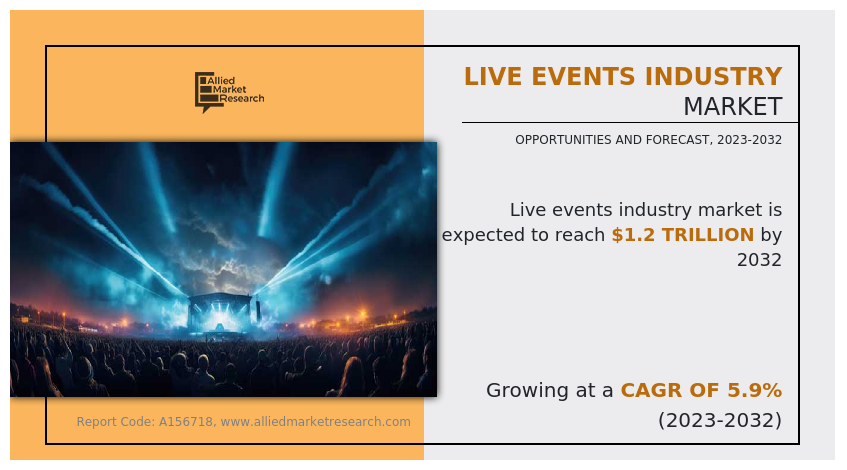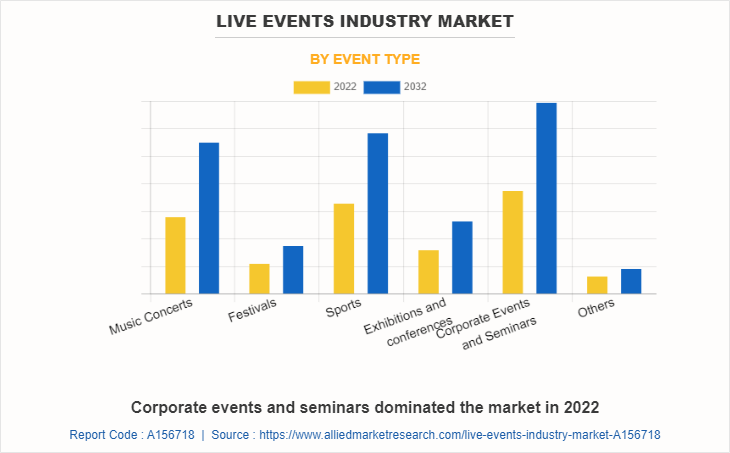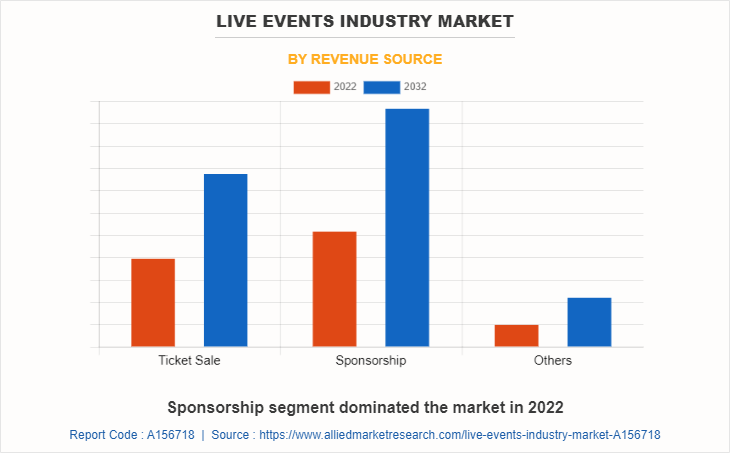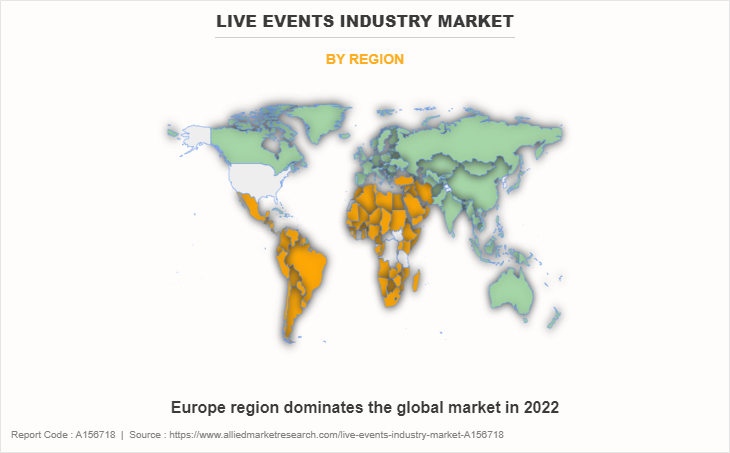Live events industry Market Summary
The global Live events industry market size was estimated at USD 652.6 billion in 2022 and is projected to reach USD 1,177.1 billion by 2032, growing at a CAGR of 5.9 % from 2023 to 2032. Growth in the live events industry is driven by renewed interest in face-to-face engagement, increased brand activation events, recovery of entertainment and sports sectors, and supportive government reopening policies.
The Live events industry market in Europe held a significant share of over 36% in 2022.
The Live events industry market industry in the Australia is expected to grow significantly at a CAGR of 8.0% from 2023 to 2032.
By event type, the music concerts segment is one of the fastest growing segments in the market and accounted for the revenue share of over 21% in 2022.
By revenue source, the ticket sale segment is one of the dominant segment in the market in 2022.
Market Size & Forecast
2022 Market Size: USD 652.6 Billion
2032 Projected Market Size: USD 1,177.1 Billion
CAGR (2023-2032): 5.9%
Europe: Largest market in 2022
Asia Pacific: Fastest growing market during forecast period

MARKET DYNAMICS
The surge in sponsorship has emerged as a major driving force within the live events industry market, which has brought a significant influence that has helped it to boom in past few years and has increased the live events industry market Demand. Elevated sponsorship levels have a direct effect on the financial landscape of event organizers. This infusion of sponsorship capital translates into a heightened pool of financial resources at the disposal of organizers. In addition, these financial reinforcements empower event organizers to increase event quality, which enhances critical elements such as production values, infrastructure augmentation, and the holistic execution of events. It helps to bring in the incorporation of cutting-edge technologies and pioneering concepts into event setups, impressive stage designs that transform venues into immersive experiences, and the introduction of elevated attendee amenities that set new standards for comfort and satisfaction.
The convergence of enhanced production values, state-of-the-art technologies, and superior amenities creates an event that is not merely attended but experienced in its entirety. This elevation of the experiential quotient in an event resonates profoundly with attendees, which gradually draws them into an immersive world of engagement, interaction, and lasting memories. Sponsorship serves as the catalyst that propels events beyond their conventional boundaries, creating an atmosphere of anticipation and excitement.
Moreover, sponsors themselves stand to gain a substantial return on their investment, primarily through exposure of their brands and products to a large number of audiences. The strategic alignment of a sponsor's brand with a particular event brings forth a myriad of opportunities to enhance brand visibility, fortify brand recognition, and cultivate a lasting brand presence. This symbiosis is particularly potent in the context of event marketing efforts, where sponsors leverage their association with the event to engage with a captive audience that is predisposed to share, discuss, and interact with the event content.
Furthermore, insights collected from collaborative research conducted by the European Sponsorship Association and Nielsen highlights the profound role of sponsorship in the recovery journey of the industry following the overall downfall brought about by the pandemic. In 2020, the realm of non-sport sponsorship witnessed a marked decline, juxtaposed against the more resilient sphere of sports sponsorship. Yet, the subsequent year of 2021 witnessed a remarkable turnaround, with non-sport sponsorships soaring by a staggering 85%, while sports sponsorship experienced a more modest uptick of 4%. Parallel narratives of resurgence were also evident in regions such as Russia, which experienced a sponsorship surge of 32%, closely trailed by the UK and Italy with uplifts of 20% and 19%, respectively. These insights underscore the pivotal role of vaccination initiatives and the subsequent resurgence of event participation as cornerstones of the revival of live events industry. However, the trajectory of recovery is neither uniform nor homogenous, owing to a number of political and economic considerations that creates challenges across different sectors and regions.
The successful execution of live events industry market comprises of complex expenses that significantly impact the overall outcome of an event. Among the substantial cost factors, venue rentals contribute highest, as these costs are intricately tied to the location of the event and the facilities provided by the chosen venue. The allure of premium venues with advanced amenities often escalates these expenses, amplifying budget considerations. Integration of cutting-edge audio-visual and lighting equipment heightens the experiential quotient of live events. The need for top-notch sound quality and visual impact necessitates the acquisition and operation of sophisticated equipment, which thus adds up to the overall expenditure. Personnel expenses emerge as a critical component for seamless event execution. Event managers, technicians, security personnel, and ushers collectively underpin event operations. The allocation for these skilled individuals plays a pivotal role, as event managers orchestrate planning and execution, technicians navigate intricate technicalities, security personnel ensure safety, and ushers facilitate guest experiences. Effective audience engagement in Live Events Industry Market hinges on robust marketing and promotional activities, which spreads awareness about the audiences and attract them toward the event. Substantial investment is requisite to build awareness and foster participation. Comprehensive strategies, spanning digital and traditional channels, entail costs for campaigns, advertising, social media outreach, and public relations. The integration of catering and hospitality services, while enhancing attendee satisfaction, further augments expenditure. Adherence to regulatory norms constitutes a fundamental aspect of event organization, as the acquisition of permits, licenses, insurance coverage, and robust security measures are non-negotiable. These measures ensure legal compliance and stakeholder safety, that adds additional costs for an event organizer, thus helping in the growth of Live Events Industry Market. Contingency planning is a financial imperative in event management. Unavoidable disruptions, such as bad weather or technical glitches, can compromise event flow, thus allocating resources to address such contingencies allows flexibility, enabling swift adaptation and resource reallocation.
The advanced technologies are profoundly reshaping the dynamics of live events and serves as an opportunity for key players in the live events industry. The strategic utilization of tools like mobile apps, event platforms, and interactive solutions has ushered in an era of real-time engagement between attendees and event content. This synthesis engenders an immersive experience that captivates and sustains audience attention, thereby augmenting audience retention. These tools furnish event organizers with analytical insights into attendee behavior, preferences, and interaction patterns. This data-driven approach empowers organizers to make informed decisions, allowing them to fine-tune strategies based on quantifiable metrics. This, in turn, cultivates a culture of continuous improvement that permeates the entire event lifecycle. In addition, this technology optimizes intricate aspects such as event logistics, attendee registrations, and communication protocols. The outcome is a streamlined planning process that unburdens organizers and ensures the seamless organization of the event. Moreover, the integration of e-ticketing, QR codes, and mobile check-ins introduces a layer of convenience that simplifies ticketing procedures, enhances attendee experience, and drastically reduces entry wait times. Furthermore, it propels the live events industry forward by bolstering engagement, operational efficiency, personalization capabilities, marketing strategies, and overall audience outreach. This paradigm shift translates into a heightened attendee experience that redefines live events as interactive, all-inclusive, and profoundly resonant engagements.
SEGMENTAL OVERVIEW
The live events industry market is segmented into type, revenue source, age group, and region. Based on type, the market is divided into music concerts, festivals, sports, exhibitions & conferences, corporate events & seminar, and others. On the basis of revenue source, it is segregated into ticket sale, sponsorship, and others. By age group, it is fragmented into below 20 years, 21–40 years, and above 40 years. Region wise, the market is analyzed across North America, Europe, Asia-Pacific, and LAMEA.
BY TYPE

The corporate events and seminars segment, as per type, dominated the global events industry market in 2022 and is anticipated to maintain its dominance throughout the forecast period, which thus helps to increase the live events industry market size. Corporate events and seminars consist of occasions deliberately structured to foster a learning-through-engagement ambiance, achieved through practical exercises, and active participation among attendees. These gatherings showcase presentations from experts, immersive hands-on demonstrations, and equally provide a platform for employees and participants to raise inquiries and engage in discussions. This category includes a range of gatherings, such as conventions, symposia, congresses, incentive group events, marketing initiatives, special commemorations, seminars, training sessions, public or trade exhibitions, product launches, exhibitions, and skill-enhancement programs. The magnitude and formality of these events can vary based on their intended purpose. The preparatory phase for these gatherings initiates approximately a month in advance, involving the conceptualization and development of a thematic framework for the attendees. Corporate events and seminars assume the dual role of nurturing existing and prospective client relationships while concurrently reinforcing ties with business associates. These events function as a conduit for conveying strong messages that motivate employees, stakeholders, and partners, along with advancement of a collective sense of purpose.
BY REVENUE SOURCE

As per revenue source, the sponsorship segment dominated the global live events industry market in 2022 and is anticipated to maintain its dominance throughout the forecast period. Sponsorship plays a pivotal role in robust marketing strategies as it serves as a cornerstone due to the prevalent utilization of sponsorships by live events to enhance program offerings and offset escalating expenses. Collaborating with sponsors enables event organizers to cover event costs and also generate substantial profits. It acts as a potent tool that synergizes with other marketing initiatives, effectively conveying messages to the target audience. Moreover, sponsorship amplifies brand recognition by exposing events to broader audiences, heightening visibility for sponsors, and fostering a positive connection between the event and its backers. Furthermore, event sponsorship extends reach to potential buyers and customers, subsequently bolstering sales and boosting the market size during the live events industry market forecast.
BY AGE GROUP

As per age group, the 21-40 years segment dominated the global live events industry market in 2022 and is anticipated to maintain its dominance throughout the forecast period. The significant growth of this market, especially among individuals aged between 21 and 40 years, can be attributed to their enthusiastic engagement in diverse events, including exhibitions, conferences, seminars, and music concerts. This age group actively participates in various gatherings and shows, contributing to the overall market expansion. In addition, there is a rising interest in entrepreneur and business-focused seminars and conferences, where young individuals who seek to establish their own ventures may gain valuable guidance and insights. Aspiring entrepreneurs find these events beneficial in gaining essential knowledge and direction, which further fuels the market expansion within this age segment. The rising popularity of music concerts and festive gatherings is also expected to positively impact the overall live events industry market growth.
BY REGION

Region-wise, Europe is predicted to dominate the market with the largest live events industry market share during the forecast period (2023-2032). Germany and Spain are projected to witness notable growth in events, spanning a variety of live events, characterized by increased number of attendees. Cost-conscious companies are driving demand for events at mid-scale venues such as conferences, seminars, and festivals, along with emphasizing on proximity. Europe is successful in attracting international association to organize conferences, which is underscored by a majority of top destinations being within the region. The adoption of smart devices and internet use has led to a rise in online bookings for music concerts, sports events, and similar gatherings. European governments actively support the live events sector, owing to its significant impact on the GDP of countries such as the UK, Germany, Netherlands, Belgium, and Czechia.
Asia-Pacific region is undergoing rapid event industry growth, propelled by robust economic expansion, regional collaboration, and intellectual progress. This growth is seen through the rise of sports leagues, digital advancements, and adoption of innovative technology. Youth interest, especially in India and China, is fueling attendance at conferences, exhibitions, concerts, and other live events. Strong economic growth in densely populated countries presents huge opportunities for investors, amplified by widespread internet and tech usage that enhances event awareness. Social media has emerged as a crucial tool to reach a wide audience and understand preferences to conduct successful events. Thus, Asia-Pacific region is expected to boost in terms of market growth in coming years.
COMPETITION ANALYSIS
The major players analyzed for the events industry market are Live Nation Entertainment, Inc., Bassett Events, Cvent Holding Corp., Eventbrite, Inc., BCD Group International BV, CL Events, Entertaining Asia, GL Events, Anschutz Entertainment Group, and SXSW, LLC. Players in the live events industry market are actively engaged in meeting dynamically changing customer demands by continuous production of new and innovative services with enhanced features. These market players invest in research and development to drive innovation in technology, improve functionality, and provide greater choice to their customers. As a result of which they collaborate with production partners, regulatory bodies, and industry stakeholders to navigate different services, regulatory compliance, and stay ahead of industry trends. Manufacturers are focused on expansion of their services while optimizing costs, which may help them to cater to the increase in demand from the customer.
Key Benefits For Stakeholders
- This report provides a quantitative analysis of the market segments, current trends, estimations, and dynamics of the live events industry market analysis from 2022 to 2032 to identify the prevailing live events industry market opportunities.
- The market research is offered along with information related to key drivers, restraints, and opportunities.
- Porter's five forces analysis highlights the potency of buyers and suppliers to enable stakeholders make profit-oriented business decisions and strengthen their supplier-buyer network.
- In-depth analysis of the live events industry market segmentation assists to determine the prevailing market opportunities.
- Major countries in each region are mapped according to their revenue contribution to the global market.
- Market player positioning facilitates benchmarking and provides a clear understanding of the present position of the market players.
- The report includes the analysis of the regional as well as global live events industry market trends, key players, market segments, application areas, and market growth strategies.
Live Events Industry Market Report Highlights
| Aspects | Details |
| Market Size By 2032 | USD 1.2 trillion |
| Growth Rate | CAGR of 5.9% |
| Forecast period | 2022 - 2032 |
| Report Pages | 270 |
| By Event Type |
|
| By Revenue Source |
|
| By Age Group |
|
| By Region |
|
| Key Market Players | Entertaining Asia, Live Nation Entertainment, Inc., Cvent Holding Corp., Eventbrite, Inc., BCD Group International BV, SXSW, LLC, Anschutz Entertainment Group, CL Events, GL Events Group, Bassett Events |
Analyst Review
According to the perspective of the top-level CXOs, the events industry is growing at a significant pace, and is anticipated to continue this trend in the coming years. Live events are playing a vital role in revenue generation and brand recognition for corporates and associations. It has been witnessed that events of the recent years are equally interesting than the past decade, driving shifts in choice and pressurizing event planners and owners. This industry is witnessing the entry of new and independent players who are leveraging technology to gain a competitive advantage in today’s consolidated environment. However, companies are facing challenges in this industry to manage live inventory for simple and small events. Thus, the focus of companies is to enhance attendee experience and witness successful completion of an event without any hindrance.?
The live events industry serves as a potent means for businesses to establish meaningful connections with their customers, employees, and partners. In an increasingly digital world, the events sector is poised to undergo further advancements and expansion. For instance, as per insights shared by Marcie Jastrow, Chief Executive Officer of Live Nation Entertainment, the prevailing outlook suggests that the live events sector is primed for substantial expansion in the forthcoming years. Thus, with an astute vision, the company is investing in the latest technologies, venturing into untapped markets, and formulating methodologies to captivate audiences. In response to the ongoing evolution of technology and shifting consumer preferences, businesses will proactively adjust their event strategies to maintain relevance and effectively engage their target audiences. Furthermore, the corporate event sector is experiencing a surge in demand as companies seek fresh avenues to captivate their staff and clientele. Thus, customers are in pursuit of memorable and significant experiences that offer attendees distinctive moments. Furthermore, there is a widespread belief that the event industry is well-equipped to satisfy this demand in the forthcoming years.
The global live events industry market was valued at $652.6 billion in 2022, and is projected to reach $1,177.1 billion by 2032
The global Live Events Industry is projected to grow at a compound annual growth rate of 5.9% from 2023 to 2032 $1,177.1 billion by 2032
The top companies analyzed for global live events industry market report are Live Nation Entertainment, Inc., Bassett Events, Cvent Holding Corp., Eventbrite, Inc., BCD Group International BV, CL Events, Entertaining Asia, GL Events, Anschutz Entertainment Group, and SXSW, LLC.
Europe holds the maximum market share of the live events industry market.
interest in face-to-face engagement, increased brand activation events, recovery of entertainment and sports sectors
Loading Table Of Content...
Loading Research Methodology...



